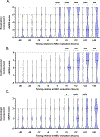Evaluation of the Neonatal Sequential Organ Failure Assessment and Mortality Risk in Preterm Infants with Necrotizing Enterocolitis
- PMID: 35313308
- PMCID: PMC9117503
- DOI: 10.1159/000522560
Evaluation of the Neonatal Sequential Organ Failure Assessment and Mortality Risk in Preterm Infants with Necrotizing Enterocolitis
Abstract
Introduction: The neonatal sequential organ failure assessment (nSOFA) score is a tool for calculating mortality risk of infants in the neonatal intensive care unit. The utility of the nSOFA in determining the risk of mortality or the association with surgical intervention among infants with necrotizing enterocolitis (NEC) has not been investigated.
Methods: We performed a retrospective, cohort study of preterm (<37 weeks) infants with NEC Bell's stage ≥ IIA at six hospitals from 2008 to 2020. An nSOFA score (range 0-15) was assigned to each patient at nine time points from 48 h before or after clinical illness was suspected.
Results: Of the 259 infants, nSOFA scores for infants who died (n = 39) or had the composite outcome of surgery or death (n = 114) were significantly higher (p < 0.05) early in the NEC course compared to nSOFA scores for infants who survived medical NEC. Twelve hours after evaluation, the area under the receiver operating characteristic curve was 0.87 (95% confidence interval [CI], 0.80-0.93) to discriminate for mortality and 0.84 (95% CI, 0.79-0.90) for surgery or death (p < 0.001). A maximum nSOFA score of ≥4 at -6, 0, 6, or 12 h following evaluation was associated with a 20-fold increase in mortality and 19-fold increase in surgery or death compared with a score of <4 (p < 0.001).
Conclusion: In this multicenter cohort, the nSOFA score was able to discriminate well for death as well as surgery or death among infants with NEC. The nSOFA is a clinical research tool that may be used in infants with NEC to improve classification by objective quantification of organ dysfunction.
Keywords: Illness severity; Necrotizing enterocolitis; Neonate; Organ dysfunction.
© 2022 S. Karger AG, Basel.
Figures





Similar articles
-
Development of a Prediction Model for Surgery or Early Mortality at the Time of Initial Assessment for Necrotizing Enterocolitis.Am J Perinatol. 2024 Sep;41(12):1714-1727. doi: 10.1055/a-2253-8656. Epub 2024 Jan 25. Am J Perinatol. 2024. PMID: 38272063
-
Comparing nSOFA, CRIB-II, and SNAPPE-II for predicting mortality and short-term morbidities in preterm infants ≤32 weeks gestation.Ann Med. 2024 Dec;56(1):2426752. doi: 10.1080/07853890.2024.2426752. Epub 2024 Nov 9. Ann Med. 2024. PMID: 39520140 Free PMC article.
-
Sepsis and Mortality Prediction in Very Low Birth Weight Infants: Analysis of HeRO and nSOFA.Am J Perinatol. 2023 Mar;40(4):407-414. doi: 10.1055/s-0041-1728829. Epub 2021 May 10. Am J Perinatol. 2023. PMID: 33971672 Free PMC article.
-
Probiotics for prevention of necrotizing enterocolitis in preterm infants.Evid Based Child Health. 2014 Sep;9(3):584-671. doi: 10.1002/ebch.1976. Evid Based Child Health. 2014. PMID: 25236307 Review.
-
Maternal probiotic supplementation for prevention of morbidity and mortality in preterm infants.Cochrane Database Syst Rev. 2018 Dec 12;12(12):CD012519. doi: 10.1002/14651858.CD012519.pub2. Cochrane Database Syst Rev. 2018. PMID: 30548483 Free PMC article.
Cited by
-
Detection of an intestinal cell DNA methylation signature in blood samples from neonates with necrotizing enterocolitis.Epigenomics. 2025 Mar;17(4):235-245. doi: 10.1080/17501911.2025.2459552. Epub 2025 Feb 2. Epigenomics. 2025. PMID: 39894787
-
Data-driven longitudinal characterization of neonatal health and morbidity.Sci Transl Med. 2023 Feb 15;15(683):eadc9854. doi: 10.1126/scitranslmed.adc9854. Epub 2023 Feb 15. Sci Transl Med. 2023. PMID: 36791208 Free PMC article.
-
Neonatal sequential organ failure assessment score within 72 h after delivery reliably predicts bronchopulmonary dysplasia in very preterm infants.Front Pediatr. 2023 Sep 29;11:1233189. doi: 10.3389/fped.2023.1233189. eCollection 2023. Front Pediatr. 2023. PMID: 37842024 Free PMC article.
-
Neonatal Sequential Organ Failure Assessment (nSOFA) Score within 72 Hours after Birth Reliably Predicts Mortality and Serious Morbidity in Very Preterm Infants.Diagnostics (Basel). 2022 May 28;12(6):1342. doi: 10.3390/diagnostics12061342. Diagnostics (Basel). 2022. PMID: 35741152 Free PMC article.
-
Methods of identifying surgical Necrotizing Enterocolitis-a systematic review and meta-analysis.Pediatr Res. 2025 Jan;97(1):45-55. doi: 10.1038/s41390-024-03292-3. Epub 2024 Jun 7. Pediatr Res. 2025. PMID: 38849483 Free PMC article.
References
-
- Henry MC, Moss RL. Neonatal necrotizing enterocolitis. Semin Pediatr Surg. 2008. May;17(2):98–109. - PubMed

